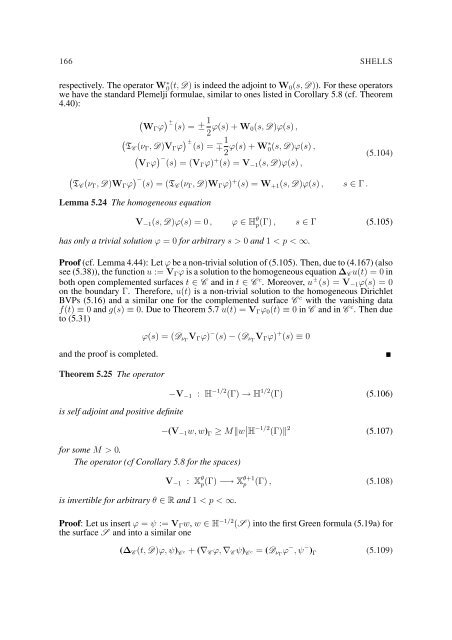EQUATIONS OF ELASTIC HYPERSURFACES
EQUATIONS OF ELASTIC HYPERSURFACES
EQUATIONS OF ELASTIC HYPERSURFACES
You also want an ePaper? Increase the reach of your titles
YUMPU automatically turns print PDFs into web optimized ePapers that Google loves.
166 SHELLS<br />
respectively. The operator W ∗ 0(t, D) is indeed the adjoint to W 0 (s, D)). For these operators<br />
we have the standard Plemelji formulae, similar to ones listed in Corollary 5.8 (cf. Theorem<br />
4.40):<br />
(<br />
WΓ ϕ ) − + (s) = −<br />
+ 1 2 ϕ(s) + W 0(s, D)ϕ(s) ,<br />
(<br />
TC (ν Γ , D)V Γ ϕ ) − + (s) = + −1 2 ϕ(s) + W∗ 0(s, D)ϕ(s) ,<br />
(<br />
VΓ ϕ ) −<br />
(s) = (VΓ ϕ) + (s) = V −1 (s, D)ϕ(s) ,<br />
(5.104)<br />
(<br />
TC (ν Γ , D)W Γ ϕ ) −<br />
(s) = (TC (ν Γ , D)W Γ ϕ) + (s) = W +1 (s, D)ϕ(s) , s ∈ Γ .<br />
Lemma 5.24 The homogeneous equation<br />
V −1 (s, D)ϕ(s) = 0 , ϕ ∈ H θ p(Γ) , s ∈ Γ (5.105)<br />
has only a trivial solution ϕ = 0 for arbitrary s > 0 and 1 < p < ∞.<br />
Proof (cf. Lemma 4.44): Let ϕ be a non-trivial solution of (5.105). Then, due to (4.167) (also<br />
see (5.38)), the function u := V Γ ϕ is a solution to the homogeneous equation ∆ C u(t) = 0 in<br />
both open complemented surfaces t ∈ C and in t ∈ C c . Moreover, u −+ (s) = V −1 ϕ(s) = 0<br />
on the boundary Γ. Therefore, u(t) is a non-trivial solution to the homogeneous Dirichlet<br />
BVPs (5.16) and a similar one for the complemented surface C c with the vanishing data<br />
f(t) ≡ 0 and g(s) ≡ 0. Due to Theorem 5.7 u(t) = V Γ ϕ 0 (t) ≡ 0 in C and in C c . Then due<br />
to (5.31)<br />
and the proof is completed.<br />
Theorem 5.25 The operator<br />
is self adjoint and positive definite<br />
ϕ(s) = (D νΓ V Γ ϕ) − (s) − (D νΓ V Γ ϕ) + (s) ≡ 0<br />
for some M > 0.<br />
The operator (cf Corollary 5.8 for the spaces)<br />
is invertible for arbitrary θ ∈ R and 1 < p < ∞.<br />
−V −1 : H −1/2 (Γ) → H 1/2 (Γ) (5.106)<br />
−(V −1 w, w) Γ ≥ M‖w ∣ ∣ H −1/2 (Γ)‖ 2 (5.107)<br />
V −1 : X θ p(Γ) −→ X θ+1<br />
p (Γ) , (5.108)<br />
Proof: Let us insert ϕ = ψ := V Γ w, w ∈ H −1/2 (S ) into the first Green formula (5.19a) for<br />
the surface S and into a similar one<br />
(∆ C (t, D)ϕ, ψ) C c + (∇ C ϕ, ∇ C ψ) C c = (D νΓ ϕ − , ψ − ) Γ (5.109)

















